EXPEDITION NOTES
Youngest Americans Reach the North Pole
The youngest Americans to reach the North Pole returned safely home last month.
Three-and-a-half-year-old Ronin Phi Garriott de Cayeux and sibling Kinga Shuilong Garriott de Cayeux, 5 years old, joined two other children in setting the record on an expedition led by their father, Austin, Texas, adventurer, video-game designer and citizen astronaut Richard Garriott de Cayeux, known to gamers as “Lord British.”
The group included the youngest American, British, French, Luxembourgish and Taiwanese-Chinese explorers on record with a goal of studying climate change and the indigenous Inuit people.
The trip spanned from April 13-22 with access to the geographic North Pole via Norway's Svalbard Islands and the Russian Barneo ice camp, according to Garriott de Cayeux.
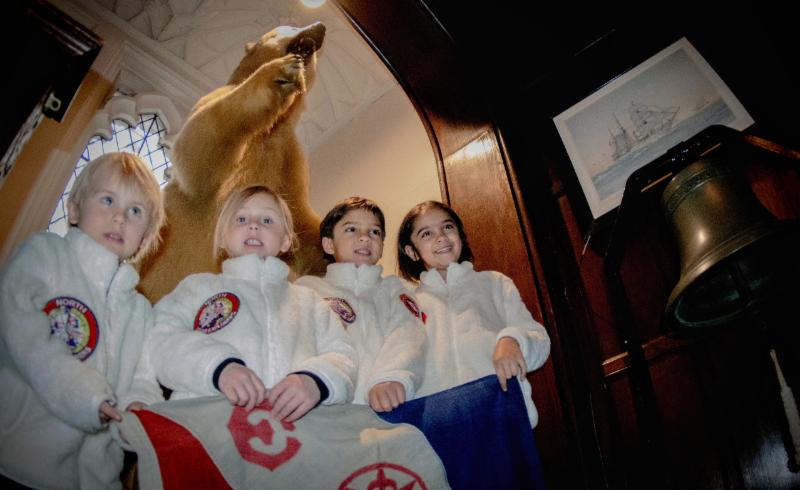
The pint-sized polar explorers traveling to the North Pole last month were (left to right) Ronin Phi Garriott de Cayeux, Kinga Shuilong Garriott de Cayeux, Olivier Ren Kraus (age 7) and Maika Ai Kraus (age 7). They hold Explorers Club Flag #61 which they took on their expedition.
One inspiration for the trip was the Explorers Club Young Explorers Program. Garriott de Cayeux is on the Club’s board.
Previously, the youngest-ever records were held by Jaimie Donovan, eight, from Galway, Ireland, who flew out to the Arctic with her father, Irish endurance runner Richard Donovan, in 2012; and Alicia Hempleman-Adams (UK), also age eight, who stood at the geographic North Pole in 1997 to meet her father, the well-known adventurer David Hempleman-Adams (UK), at the end of his successful trek to the pole, according to the World Record Academy (www.worldrecordacademy.com).
Watch news coverage of the recent expedition here:
Twin seven-year-olds Maika and Olivia Kraus appeared on New York TV prior to departure:
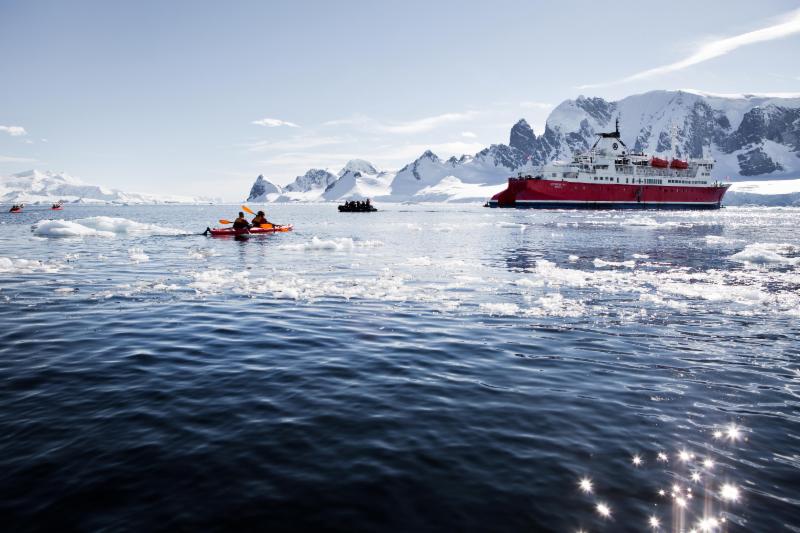
(Photo courtesy IAATO /Lauren Farmer)
Antarctica Visitation Up 17-22%
The International Association of Antarctica Tour Operators (IAATO) reported its visitor numbers for the 2017-2018 Antarctic season. The upward trend in visitor numbers recorded since 2011-2012 continued in 2017-2018. The majority, 41,996, of visitors traveled by sea to Antarctica on vessels offering excursions ashore, representing a 16% increase compared to the previous year. Of these, 3,408 flew to the South Shetland Islands on the Antarctic Peninsula where they immediately boarded a vessel for onward travel. In addition, 9,131 visitors experienced Antarctica on one of four cruise-only vessels that do not make landings, an increase of 22% since 2016-2017.
Five-hundred-eighty visitors flew to field camps in Antarctica’s interior with IAATO land operators. Overall, the total number of Antarctic visitors in 2017-2018 was 51,707, an increase of 17% compared to the previous season. IAATO has been monitoring, analyzing and reporting trends since 1991 as part of its commitment to “leave only footprints” through the effective self-management of its activities. All visitor activities follow strict codes of conduct developed by IAATO and through the Antarctic Treaty System.
Overall American visitors remained the most numerous, accounting for 33% of the total number, the same proportion as the previous year. Chinese visitors were the second most numerous, accounting for 16% of all visitors and increasing by 4 percentage points compared to 2016-2017. Australian, German and British visitors were the next most enthusiastic visitor nationalities, accounting for 11%, 7% and 7% respectively.
Tour operators are conscious not to kill the golden goose. IAATO requires its members to abide by the Antarctic Treaty System. Tour operators refrain from making any landings in Antarctica from vessels carrying more than 500 passengers. They also coordinate with each other so that not more than one vessel is at a landing site at any one time, no more than 100 people are ashore at once and a staff: passenger ratio of up to 1:20 is maintained.
Read the complete announcement here:
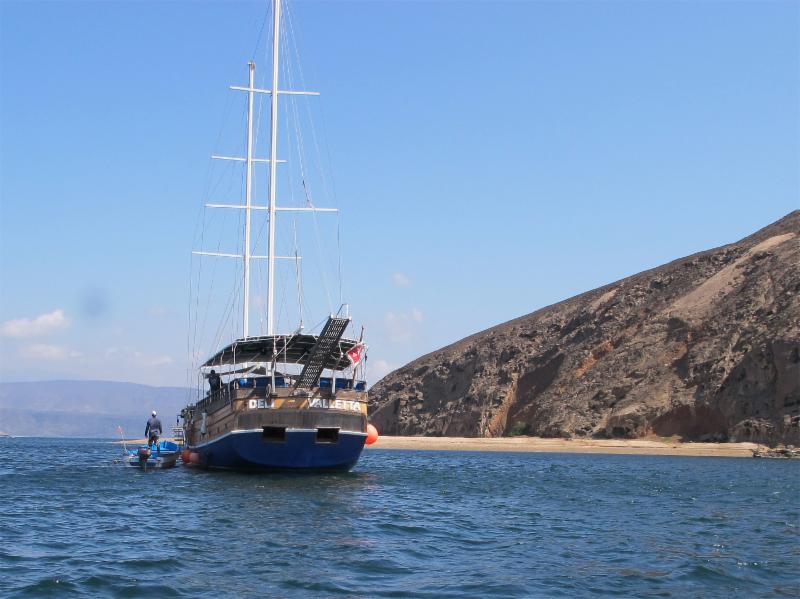
Live aboard this Turkish gulet while volunteering on a whale shark research study.
Space Available on Djibouti Whale Shark Research Expedition
Teammates are being sought to join an expedition to study whale sharks in the Gulf of Tadjoura, a gulf of the Indian Ocean in the Horn of Africa, Nov. 30 to Dec. 8, 2018. The project will be led by Shark Research Institute Director of Science & Research, Dr. Jennifer Schmidt. Participants will serve as research assistants, documenting whale sharks by photo identification, collecting and analyzing plankton samples and observing night feeding behavior.
Research goals are to understand where these animals come from, why young sharks congregate in this area, and where they go when they leave. Home for this liveaboard expedition is the M/V Deli, a Turkish gulet (wooden sailing boat) that accommodates 12 people in shared rooms with private baths.
Both whale shark interactions and diving are available each day, and participants may choose any combination of activities. Cost: $2,200 double occupancy, includes shared accommodation onboard, land-based hotel stays, and meals onboard the ship. Airfare is extra.
For more information: www.sharks.org, Jennifer@sharks.org at Shark Research Institute Global, Princeton, N.J.
Five Women Explorers Inducted as WINGS WorldQuest Fellows
WINGS WorldQuest, a nonprofit organization which supports and recognizes extraordinary women in science and exploration, awarded five recipients its 2018 Women of Discovery Awards during a ceremony in New York on April 25, 2018.
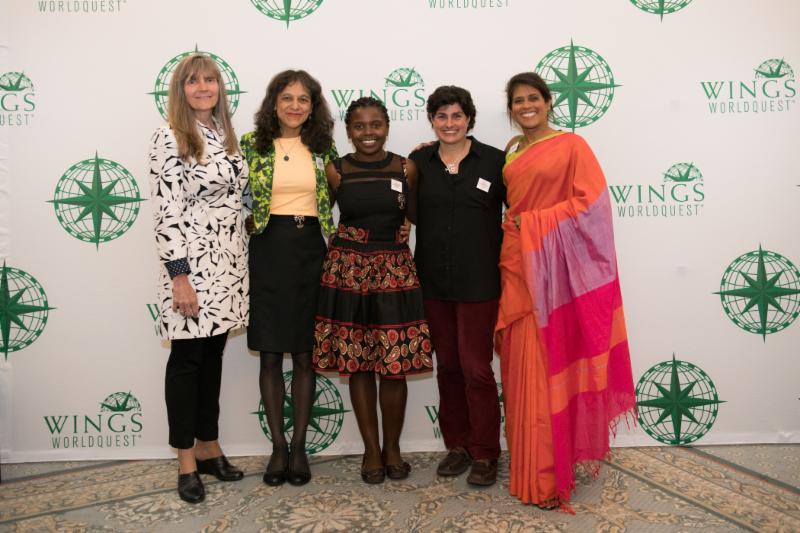
WINGS WorldQuest Honorees (l-r) - Eleanor Sterling, Ph.D., Nalini Nadkarni, Ph.D., Thandiwe Mweetwa, Nergis Mavalvala, Ph.D., and Asha De Vos, Ph.D.
The WINGS WorldQuest Women of Discovery Awards were established in 2003 to recognize extraordinary women making significant contributions to world knowledge and science through exploration. Unique to this honor and organization is the $10,000 unrestricted grant that is bestowed on each Fellow, to use as she sees fit to advance her research, career, and expeditions.
In 15 years, 79 pioneering women have been bestowed as Fellows, and WINGS Worldquest has granted over $550,000.
The five are:
Asha De Vos, Ph. D.
Sea Award
A Sri Lankan marine biologist, ocean educator and pioneer of blue whale research within the Northern Indian Ocean.
Nergis Mavalvala, Ph. D.
Air and Space Award
She is a physicist whose research focuses on the detection of gravitational waves from violent events in the cosmos that warp and ripple the fabric of spacetime.
Thandiwe Mweetwa
Conservation Award
Her work focuses on studying population dynamics and threats to survival of lions and other carnivores in eastern Zambia in order to protect the species and their habitat.
Nalini Nadkarni, Ph.D.
Lifetime Achievement Award
Known as the "Queen of the Forest Canopy." For three decades, she has used mountain-climbing techniques, construction cranes, and hot air balloons to explore life in the treetops of Costa Rica and the Pacific Northwest, documenting biota that are rarely or never seen on the forest floor.
Eleanor Sterling, Ph. D.
Humanity Award
Dr. Sterling is passionate about the intersection between biodiversity, culture, and languages. She works to strengthen connections, between people and place, across communities, and through time.
QUOTE OF THE MONTH
“Travel is fatal to prejudice, bigotry, and narrow-mindedness, and many of our people need it sorely on these accounts. Broad, wholesome, charitable views of men and things cannot be acquired by vegetating in one little corner of the earth all one's lifetime."
- Mark Twain aka Samuel Langhorne Clemens (1835-1910), American writer, humorist, entrepreneur, publisher, and lecturer.
EXPEDITION FOCUS

U.S. State Department Changes Travel Advisory System
The U.S. State Department recently changed how it issues warnings to U.S. citizens about international travel. Previously the agency released advisories, warnings, or bulletins about specific nations, which caused some confusion. “What’s the difference between a travel warning and a travel alert?” people wondered.
The system has changed so that each country now has an advisory - not a rule, but instead a “recommendation” - rated on a four-point threat scale. The lower the number, the lower the risk: (1) Exercise Normal Precautions (blue), (2) Exercise Increased Caution (yellow), (3) Reconsider Travel (orange), and (4) Do Not Travel (red).
Not surprisingly, countries such as Afghanistan, Iran, Iraq, and Syria fall within the highest category because of the likelihood of life-threatening risks and the U.S. government’s limited ability to provide help.
CBS travel correspondent Peter Greenberg criticizes the new program because it’s not well defined. “Once you get beyond the first category, I still don’t know what that means. Does it mean ‘don’t trip’? And ‘Exercise Increased Caution,’ does that mean ‘don’t trip and fall’?
“Most people, once it gets beyond the second category, decide ‘I’m not going,’ he tells CBS This Morning last Jan. 16. “My own personal metric is that I will not go anywhere where I don’t know who’s in control, but putting Mazatlán in the same department as Syria and Yemen is not really helping people.”
The warnings are split even further by country according to Crime, Terrorism, Civil Unrest, Health, Natural Disaster and Time-Limited Event, which Greenberg thinks is a good idea.
Enter your destination country and the threat level will be displayed along with alerts and visa requirements. What’s more, a color-coded map also identifies the world’s hot spots. Through its Smart Traveler Enrollment Program (STEP), you provide details of your trip and are then placed on an email list to receive Travel Advisories and Alerts as soon as they are issued.
Staff columnist Stephanie Rosenbloom writes in The New York Times, “The smartest way to use the rankings to help decide if a trip is right for you is to read the explicit risks on the country page, which on the overhauled website are more clearly explained.”
For more information:
MEDIA MATTERS
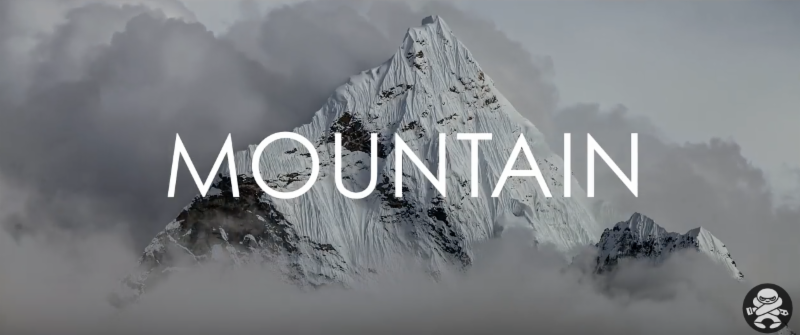
Mountain is Momentous
Narrated by Willem Dafoe, Mountain is a cinematic and musical collaboration between acclaimed director Jennifer Peedom (Sherpa) and the Australian Chamber Orchestra, one of the world’s great chamber orchestras.
Mountain is a vertiginous juxtaposition of image and music that explores the powerful force that mountains hold over our imaginations. Only three centuries ago, setting out to climb a mountain would have been considered close to lunacy. Mountains were places of peril, not beauty, an upper world to be shunned, not sought out. Why do mountains now hold us spellbound, drawing us into their dominion, often at the cost of our lives?
From Tibet to Australia, Alaska to Norway armed with drones, Go-Pros, and helicopters, the filmmakers have fashioned an astonishing symphony of mountaineers, ice climbers, free soloists, heli-skiers, wingsuiters snowboarders and parachuting mountain bikers.
See the trailer here:

Justin Fornal in full regalia at The Explorers Club Annual Dinner, March 2018 (Photo by Rod Mickens)
18 Most Adventurous People in the World
MensJournal.com is out with its list of the “18 Most Adventurous People in the World Right Now” (posted in April). It’s a list that may surprise you. In addition to well-known adventurers free solo rock climber Alex Honnold, alpinist Jess Roskelley, and polar explorer Felicity Aston, is the lesser-known Justin Fornal, a so-called Cultural Explorer - he’s a cultural detective, extreme athlete, a culinary explorer, and somewhat surprisingly, a resident of The Bronx.
Fornal’s projects include traveling 1,200 miles deep into the East African bush to learn more about the Buganda tribe; and swimming 100 miles around a Scottish island to create one of the rarest whiskies in the world.
Fornal’s projects include traveling 1,200 miles deep into the East African bush to learn more about the Buganda tribe; and swimming 100 miles around a Scottish island to create one of the rarest whiskies in the world.
“All my stories are obsessions,” he tells writer Will Cockrell. “And when I can combine athleticism with cultural research in the field to create something, that’s what makes it all worth it for me.”
In the future, Fornal is planning to swim 230 miles from Mali’s Mopti to Timbuktu to build a clinic and raise awareness in the fight against female genital mutilation. “At the heart of all my field research is giving people a microphone,” he says. “I want to get the stories out there while the stories can still be recorded,” he tells the website.
Read the article here:
EXPEDITION FUNDING

Alex Staniforth raised corporate sponsorship as a teenager for his expeditions to Baruntse in 2013, and Everest in 2014 and 2015.
Eight Tips for Finding Sponsorship
A guest post on TheBusinessofAdventure.com by young British endurance adventurer, speaker and mental health fundraiser Alex Staniforth, provides eight pragmatic tips for soliciting expedition sponsorship. Staniforth is author of Icefall: The True Story of a Teenager on a Mission to the Top of the World (Coventry House Publishing, 2016). He explains that sponsors, “... want to be associated with positive things, and adventures/expeditions are an exciting way for them to engage with their customers and take their brand to cool places.”
Staniforth continues, “When approaching prospective sponsors, many people get confused. They think you’re asking for charity sponsorship, that is where people raise charity sponsorship by doing challenges like marathons, cycles and skydives by family/friends/colleagues. Be clear in communicating that you’re funding the cost of the project itself.
“The other key point is sponsorship denotes a two-way relationship. A donation means the donor gets nothing in return. But sponsorship implies that the sponsor gets the return they’ve paid for, like paying a decorator to paint your kitchen. This takes a lot of work, you have a responsibility to deliver, and there are risks and consequences if you fail to do so,” Staniforth writes.
Personalizing a pitch is vitally important. “If you start an email with ‘Dear Sir/Madam’ you might as well be sending them an invite to Candy Crush Saga. Nobody likes cold, impersonal emails. Making an effort to find the appropriate contact and personalize the email will help reduce the chances of your email being trashed.”
Read more sponsorship solicitation advice here:
EXPEDITION INK
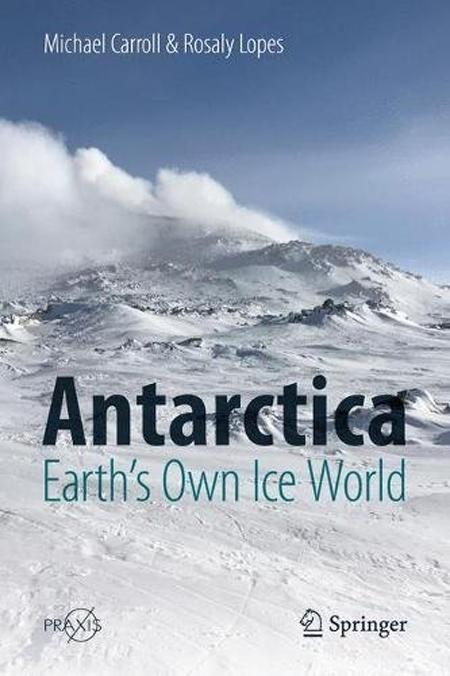
Antarctica: Earth’s Own Ice World
In 2016, Rosaly Lopes, an expert on volcanoes on the Earth and planets, and space artist Michael Carroll, teamed up as fellows of the National Science Foundation to travel on an Explorers Club flag expedition to Mount Erebus, the world’s southernmost active volcano in Antarctica. The logistics of getting there and complex operations of Antarctica's McMurdo Station echo the kinds of strategies that future explorers will undertake as they set up settlements on Mars and beyond.
Their popular-level book, Antarctica: Earth's Own Ice World (Springer Praxis Books), explores the arduous environment of Antarctica and how it is similar to other icy worlds in the Solar System and delves into Antarctica’s infrastructure, exploration, and remote camps, culminating on the summit of Erebus.
Learn more here:

Alone at the Top
What goes through your mind when you’re dropped alone in the middle of the Alaska Range, the cold and darkness surrounding you without another human being for miles?
Arctic explorer Lonnie Dupre had made a career out of working in teams to survive in extreme conditions and places most humans wouldn’t dare to tread. In 2010, looking for a new personal and professional challenge, Dupre decided he needed to summit Denali, the continent’s tallest peak - and he needed to do it alone and in the depths of the darkest, coldest conditions on the mountain.
Alone at the Top: Climbing Denali in the Dead of Winter (Minnesota Historical Society Press, 2018) by Dupre and Minneapolis Star Tribune reporter Pam Louwagie, is the dramatic story of one man’s ascent of North America’s highest peak under the harshest conditions - and the climb that nearly killed him.
Dupre was on his fourth attempt in five years in late December 2014 when a surprise storm caught him at 11,200 feet. Forced to live for almost five full days with little food and water, it was the most dangerous situation of his life.
After three failed attempts, he finally reached his goal on January 11, 2015, illuminated by the feeble afternoon winter sun.
Alone at the Top tells how he almost died in the attempt and offers a mountaineer’s firsthand perspective during life-and-death decision-making on the mountain.
Read an excerpt from the book here:
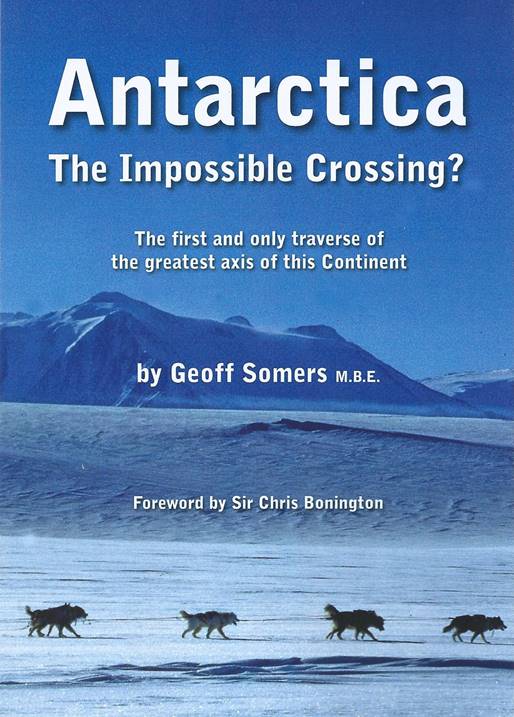
Trans-Antarctica Expedition Spawns Another Book
A number of books were spawned by the historic 1989-90 human- and dog-powered crossing of Antarctic. The latest is by UK team member Geoff Somers who, in July 1989, during the brutal months of the polar winter, accompanied five teammates from five other countries on skis to attempt a near 4,000-mile traverse of the greatest axis of Antarctica, with three teams of huskies hauling their supplies.
Across this vast expanse of ice and snow, they had to contend with extremes of cold down to minus 50 degrees F., endure ferocious blizzards, negotiate mountain passes, yawning crevasses and perpetual isolation in the most inhospitable environment on Earth.
This unprecedented trek had to be completed in 220 days before the following winter would engulf them. Somers self-published book is called, Antarctica, The Impossible Crossing? and includes a forward by Sir Chris Bonington.
Why a book now, almost 30 years later?
“It was about time I put pen to paper - for historical reasons this trip, not just because I was part of it, is important in the transition from the old way of travel to the modern. During the crossing, I kept a daily journal, trying to write at least 900 words a day - so I had plenty of text to choose from,” Somers tells us in an email.
“AND, it is unlikely to be repeated, even if participants were to start on the spine of the Antarctic Peninsula, they would not be allowed to use dogs, the logistics would probably be more costly and difficult. However, the impossible is constantly being proved possible and I would be quite happy to be proved wrong.”
BUZZ WORDS
Jesus Nut
Here’s something you don’t want to think about when you’re choppering to or from an expedition. The Jesus nut, or Jesus pin, is a slang term for the main rotor retainingnutthat holds the main rotor to the mast of some helicopters, such as the UH-1 Iroquois helicopter; or more generally is any component that represents a single point of failure with catastrophic consequences.
If the Jesus pin were to fail in flight, the helicopter would detach from the rotors and the only thing left for the crew to do would be to "pray to Jesus." (Our thanks to Scott Hamilton, president of Dooley Intermed International, for planting this gruesome thought in our impressionable heads).
EXPEDITION CLASSIFIEDS
Get Sponsored!
Hundreds of explorers and adventurers raise money each month to travel on world class expeditions to Mt. Everest, Nepal, Antarctica and elsewhere. Now the techniques they use to pay for their journeys are available to anyone who has a dream adventure project in mind, according to the book from Skyhorse Publishing called: Get Sponsored: A Funding Guide for Explorers, Adventurers and Would Be World Travelers.
Author Jeff Blumenfeld, an adventure marketing specialist who has represented 3M, Coleman, Du Pont, Lands' End and Orvis, among others, shares techniques for securing sponsors for expeditions and adventures.
Buy it here:
Coming in Fall 2018: Travel With Purpose, A Field Guide to Voluntourism by Jeff Blumenfeld (Rowman & Littlefield)
Advertise in Expedition News - For more information: blumassoc@aol.com
EXPEDITION NEWS is published by Blumenfeld and Associates, LLC, 1877 Broadway, Suite 100, Boulder, CO 80302 USA. Tel. 203 326 1200, editor@expeditionnews.com. Editor/publisher: Jeff Blumenfeld. Research editor: Lee Kovel. ©2018 Blumenfeld and Associates, Inc. All rights reserved. ISSN: 1526-8977. Subscriptions: US$36/yr. available by e-mail only. Credit card payments accepted through www.paypal.com (made payable to blumassoc@aol.com). Read EXPEDITION NEWS at www.expeditionnews.com. Enjoy the
EN blog at www.expeditionnews.blogspot.com.


